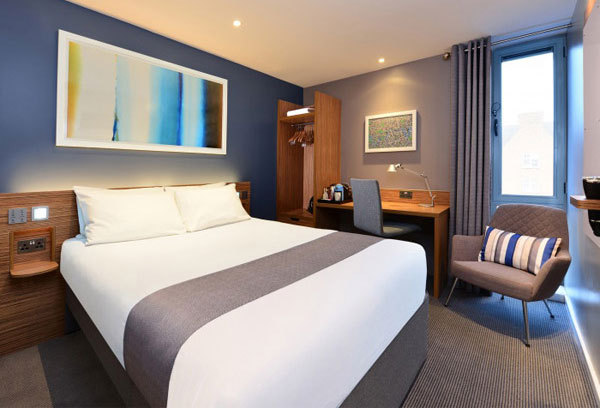✕

Column: industry Tag: hotel renovations,life of a hotel,age Published: 2017-09-07 10:11 Source: Author:

Market economics, national economics, scale, weather, guest wants and brand affiliation all enter the equation as to when renovations and closures should take place. Hoteliers with in-depth understanding of the factors involved can realize strong returns.
STR’s Dominik Kozissnik said age has the most impact on independent hotels and those on the lower chain scales. (Photo: Event Coverage Nashville)
NASHVILLE, Tennessee—There are four stages in the life of a hotel: opening; affiliation or non-affiliation to a brand; renovation (causing temporary closure or during continued operation); and permanent closure.
Having an understanding of statistics and truisms about when these stages occur across segments and markets can guide hoteliers’ decisions on when to instigate change so that an asset can work to its optimum level, according to Dominik Kozissnik, director of global census at STR, the parent company of Hotel News Now.
In a Hotel Data Conference presentation titled “Lifecycle: Does age matter?” Kozissnik said that on average in 2016, 2.4 hotels opened every day across the U.S.
In 2008 and 2009 and then again in 2016, the percentage growth of hotel rooms outpaced the percentage growth of hotels. Between 1995 and year-to-date 2017, the average size of hotels has grown approximately 56%, which translates to an average of 41 more rooms per property.
Brand relationship among chain scales
Brand affiliation often is a safeguard to the demise of an asset, Kozissnik said, due to brands’ rigorous product standards. But with each property’s additional brand affiliation, the subsequent affiliation is likely to last less time.
“It is like a bad celebrity marriage. The more marriages, the shorter each one lasts,” Kozissnik joked.
Across the chain-scale segments, the lowest average brand affiliation length is shared, more or less, by upscale properties (9.6 years) and economy properties (9.7 years), while the longest is shared by upper upscale (13.7 years) and upper midscale (13.6 years). Luxury hotels have an average brand affiliation duration of 11.9 years, which is only 2.2 years above that of the average economy property.
Will average daily rate fall in relation to affiliation and age?
Kozissnik said ADR across the majority of segments differed little in the first three years after a property opened, with the exception of luxury. Midscale and economy hotels peaked across these years very quickly before dropping, albeit very slightly.
Average ADR will fall if renovations do not take place, Kozissnik said, which means there is a cutoff year for work to begin in each segment.
Temporary closures and chain scale
The choice as to when to begin a renovation, partial or total, often depends on occupancy levels, Kozissnik said. When reduced occupancy raises alarms, one obvious questions is: Are guests not choosing the hotel because of the condition of the property?
On average, 150 hotels per year in the U.S. move into a phase of temporary closure, Kozissnik said.
Some hoteliers may choose not to close their properties during renovation but are forced to due to brand standards or even unexpected events such as Hurricane Katrina, during which 20% of properties on average were temporarily closed.
As the age of a property increases, the greatest impact is on ADR and revenue per available room in independents and lower-scale assets, while the least impact is on branded properties and the luxury and upper-upscale segments.
Market factors
Kozissnik said not all the oldest hotels are in difficult-to-access markets, although with an average property age of 57.9 years, San Francisco does fit into that mold.
Other markets do not, such as Maine (56.9 years old on average) and the New Jersey Shore (56.8 years). The “youngest” markets include Austin, Texas (21.7 years); Omaha, Nebraska (23.8 years); and Raleigh/Durham, North Carolina (24.6 years).
Hawaii (34.8%) and Nevada (30.8%) have the highest percentage of permanent closures as part of their total properties. Florida is third-highest at 22.2%, which Kozissnik said is mostly the result of properties being converted through adaptive reuse into timeshare properties. Hotels do age depending on their state, Kozissnik said. The oldest on average are in New England, Vermont and Maine.
In regards to chain scales, economy (48 years) and upper-upscale (46 years) properties are on average the oldest when they permanently close their doors.
Closed independent hotels have an average age of 72 years. Occupancy in independent hotels on average declined steadily from after their second years, Kozissnik said, although their occupancy remained steady over their first four years.
As some chains dominate some states, this average age could be the result of chains’ procedures, Kozissnik said. Climate could also be a significant factor in the property aging process.
When hotels do close, others in that market see ADR rise, Kozissnik said.
The real spike in that metric for luxury and upscale, at least for 16 such properties in Washington, D.C., occurs on average at 10 months, Kozissnik said.
Previous:MGM Growth Properties LLC To Purchase MGM National Harbor Casino Resort for $1.1875 Billion
Next:Trends to look out for when booking hotel business
Hot key words
Hot Products
Popular Vendors